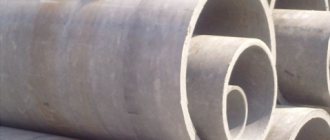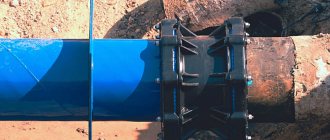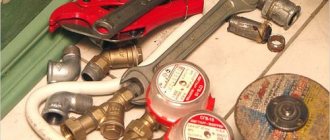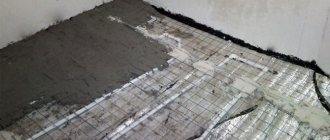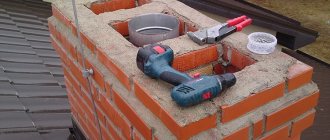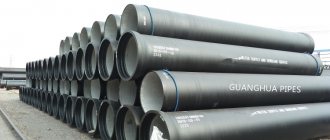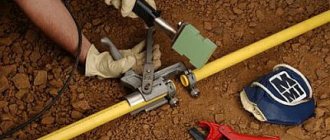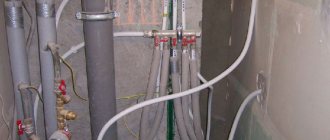Despite the rapid development of construction technologies, time-tested building materials are still widely used in industrial and civil construction. The widespread use of asbestos-cement pipes (ACP) in private construction is due to their unique technical characteristics, versatility and affordable cost.
This article discusses the main types, technical characteristics, scope of application, advantages and disadvantages of ADT. In addition, the relevant sections will detail the requirements for the laying and installation of asbestos-cement pipes and the features of their connection, both among themselves and with other elements of building structures.
What is an asbestos cement pipe?
Asbestos-cement pipes are made on the basis of components such as Portland cement (85%) and asbestos (15%). It is asbestos that reinforces the material.
At the first stage of asbestos pipe production, reinforcing fibers are formed, which are later mixed with Portland cement. The mixture thus obtained is thoroughly mixed until a homogeneous mass is obtained.
After this, the resulting solution is placed in a centrifuge, the inner diameter of which corresponds to the outer diameter of the product. Under the influence of centrifugal forces, the mixture is thrown towards the walls of the working cylinder of the centrifuge, as a result of which an asbestos-cement pipe of a given diameter is formed.
The last step is autoclaving. In a special chamber, the semi-finished product is processed with superheated steam. After this, the pipe is cut according to the requirements of the technical documentation and sent to the warehouse.
Important! Fine asbestos particles can cause irreparable harm to the respiratory system.
Carrying out work without special protective equipment is strictly prohibited!
Layout of the trench bottom and installation of a foundation for the pipeline
To create the design slope, pegs are driven into the bottom of the trench in specially dug holes at the design bottom level every 3-4 meters. The planning is done using these pegs. The bottom of the trench is carefully leveled and, in case of weak soil, compacted. A sand cushion 100 mm thick is placed under the pipeline along the prepared soil base of the trench. A sand cushion is used when laying a pipeline in dry soils. If the groundwater level is low, a gravel bed is installed. If the groundwater level is high, the entire structure is covered with sand and gravel and a drainage pipe is laid.
At the junction of pipes, pits are made for installing couplings. The length of the pit along the axis of the trench is 0.4-0.5 m, the depth is 0.15-0.2 m. The width of the pit should be 0.2 m greater than the outer diameter of the couplings (Fig. 4).
Rice. 4
Thermal chrysotile cement networks under the road should be laid in concrete trays or steel sleeves to prevent local subsidence of the soil under the pipeline and further destruction of the network.
Types of asbestos-cement pipes and their application
Depending on the purpose, asbestos-cement pipes can be produced in two versions:
- pressure;
- free-flow
Let's take a closer look at each of these modifications.
Pressure pipe
Requirements for pressure asbestos-cement pipes and their technical characteristics are regulated by GOST 539-80, according to which there are 4 modifications:
| Designation | Allowable pressure working environment in the pipeline, MPa |
| VT6 | 0,6 |
| VT9 | 0,9 |
| VT12 | 1,2 |
| VT15 | 1,5 |
Specifications
The service life and reliability of the pipeline depends on the correct choice of operating parameters of the pipes. Below are the technical characteristics of pressure asbestos-cement pipes, in accordance with GOST 539-80.
Scope of application
Due to their performance properties and affordable price, asbestos-cement pressure pipes are widely used. They are used for installation of water supply, sewerage, ventilation and drainage systems, storm drains, etc.
The material’s inertness to aggressive chemical compounds and corrosion resistance make it possible to use pressure pipes for transporting petroleum products and other aggressive media. In addition, the strength and heat resistance of the products ensures the possibility of their use in the installation of gas and steam pipelines.
Gravity pipe
Unlike pressure modifications, non-pressure asbestos-cement pipes are not used for laying pipelines operating under pressure. Technical characteristics and dimensions of non-pressure modifications are given in GOST 1839-80.
Technical characteristics of non-pressure asbestos pipes
According to GOST 1839-80, free-flow pipelines must meet the requirements given in the table:
Scope of use
Free-flow asbestos-cement pipes, due to their affordable cost, ease of installation and long service life, are widely used in industry and construction:
- when laying non-pressure water supply and sewerage communications;
- installation of garbage chutes in high-rise buildings;
- when assembling gas and chimneys;
- to protect the underground electrical network;
- as elements of a collector or drainage system;
- to protect communication cables, the Internet and other communications;
- as siege pipes for wells;
- when installing fences and fences;
- as pillars of a pile foundation;
- in private construction.
When properly used, asbestos products can last 30 years or more.
Description of material
First, you need to say a few words about what asbestos-cement pipes are and outline the fundamental properties of this material, since the nuances of the work will largely depend on this.
Asbestos-cement pipes are a material used for plumbing or sewerage work. In addition, they can be used for the manufacture of chimneys. Such pipes are made from a mixture of cement, asbestos and water. The result is a material with the following characteristic properties:
- Chemical neutrality.
- Durability of use.
- Resistant to corrosion.
- Resistant to high temperatures.
- Availability of material.
But at the same time, asbestos-cement pipes have some difficulties in operation, mainly due to the enormous weight of the pipes and the tendency of the material to crack under mechanical action.
It is fundamentally important to emphasize that asbestos-cement pipes, which are used for laying water or sewer lines, can be divided into two types:
- Non-pressure pipes.
- Pressure pipes.
As the name suggests, pipes of each type are designed either for work under pressure or without it. Depending on the type of pipes, the methods for connecting them to each other will also differ.
Advantages and disadvantages
In addition to the above technical characteristics, the high demand for asbestos-cement pipes is due to the following advantages:
- at an affordable price.
Installation of a water supply or sewer network made of asbestos cement will cost 4-5 times less than a similar metal pipeline; - resistance to electrochemical corrosion and exposure to moisture and aggressive chemical compounds,
therefore, when installing pipelines, it is not necessary to carry out waterproofing and other protective measures; - low thermal conductivity
. The use of asbestos pipes allows, in most cases, to avoid insulation of the main line; - insignificant coefficient of thermal expansion
. When the temperature of the working environment increases to 1000C, the length of a five-meter pipe increases by no more than 0.5 mm; - versatility.
Can be used in a variety of areas, from laying main pipelines and protecting cables, to installing fences and installing pile foundations; - long service life.
When properly installed, asbestos cement products last from 25 to 35 years.
In addition, during operation, asbestos-cement pipes do not require maintenance, since practically no harmful deposits accumulate on the inner surface.
Along with the above advantages, the material also has a number of disadvantages, the most significant of which are:
- Asbestos pipelines and other structures are characterized by high fragility. They do not tolerate dynamic and alternating loads;
- when the temperature rises to 250 – 3000C, the product, as a rule, is destroyed, which limits the possibility of their use in steam pipelines and chimneys;
- laying of large diameter pipelines is carried out only using special equipment.
Despite these disadvantages, products made from asbestos cement are in demand not only in private, but also in industrial construction, as well as when laying pipelines working with aggressive working environments.
Connection using a polyethylene coupling type MPT
This type of connection is the most common method of joining non-pressure asbestos-cement pipes together when laying pipelines for communication cables. This connection method is acceptable for pipes with a diameter of 300 mm, 200 mm, 150 mm, 100 mm when installed in normal dry soil.
Before proceeding to connecting pipe joints, it is necessary to heat the coupling. To do this, you need to warm it up for at least 10 minutes in a tank of water, which is heated to a temperature of 90-100 ° C.
Before proceeding to connecting pipe joints, it is necessary to heat the coupling.
The hot coupling is placed at one end on a previously laid asbestos-cement pipe until it rests against its internal partition. The end of the second asbestos-cement product from the opposite side is also inserted until it stops against the internal partition of the coupling.
In cases where it is impossible to put a polyethylene coupling of the MPT type on a pipe, an unwelded metal collar is used. For example, when performing sewer repairs with the need to replace the MPT coupling or using cut (longitudinal) asbestos-cement pipes. Docking is done using pliers. A gasket made of brizol, metalloizol or hydroisol is placed under the metal cuff. After which the cuff is tightened with pliers. The joint of asbestos-cement products, after the cuff is installed, is sealed along its entire length with cement-sand mortar, the thickness of which must be at least 10-15 mm. An integral positive factor in the use of a non-welded metal collar is that the ends of the connecting pipes do not require careful processing. After all, when repairing a sewer pipeline, we often have to cut the pipe in order to replace some of its part.
There is also a welded metal cuff, which is used in the construction of horizontal punctures (wells) under railways and roads. The welded cuff has an internal limiter, which prevents the through passage of the connected pipes. These cuffs are capable of ensuring rigid alignment of joined products.
Is it possible to use asbestos pipes for a chimney?
Despite the affordable cost and ease of installation, a chimney made of asbestos-cement pipes is not the optimal option for discharging combustion products into the atmosphere. Before you begin constructing a chimney from this material, you must consider the following factors:
- exposure of the pipe walls to hot combustion products and moisture, combined with ultraviolet radiation, leads to the material delaminating, releasing fine asbestos particles into the environment. If it enters the human body, asbestos can cause exacerbation of chronic ailments and provoke cancer;
- The permissible heating temperature of the pipes is 280 – 3000C. This fact must be taken into account when choosing a heat generator. Overheating of a pipe can lead not only to its destruction, but also to more serious consequences (it can lead to an explosion);
- the presence of pores in the structure of the material promotes intensive absorption of condensate. With a significant decrease in temperature, internal connections are disrupted, which leads to gradual destruction of the pipes;
- to connect an asbestos-cement pipe to the outlet pipe of the heating boiler, use a special stainless steel adapter;
- It is advisable to install chimney elements at the maximum distance from the heat generator.
From the above it follows that asbestos products are not the best option for installing a chimney, however, subject to the appropriate rules and recommendations, their use is quite acceptable.
How are asbestos cement pipes installed?
Next, we will highlight the most important points that have a direct impact on the process of installing asbestos cement pipelines.
- In order to obtain the required parameters and the desired roughness, the diameters of asbestos-cement pipes are ground. When connecting structures of this kind, special couplings are used. Please note that on the inner surface of the structures there are grooves with elastic rubber rings with a complex glow that resembles cuffs. This allows you to obtain a reliable and complete system. At the junction with the coupling, there is a radial gap, which ensures elastic deformation of the rubber seal. The presence of an installation gap allows you to eliminate the use of temperature compensators. It should also be noted that the coefficient of thermal elongation of asbestos cement is 12 times lower steel ratio.
Build safe asbestos-cement pipelines!
Asbestos and asbestos-cement pipes for chimneys were very popular in our country during the Soviet years. This was due to a number of reasons.
Firstly, the country had an excellent raw material base for the production of such products. Secondly, pipes made from these materials had low cost and high profitability. Thirdly, they had good technical characteristics and did not require insulation or additional insulation.
Foundation made of asbestos-cement piles: application features
Since asbestos-cement pipes have high mechanical strength and are resistant to corrosion, moisture and aggressive chemical compounds, they can be used as the basis for a pile foundation.
Asbestos-cement piles are deeply dug pipes, the interior of which is filled with concrete and reinforced. Such supports provide a long service life and have sufficient load-bearing capacity for the construction of a small residential building, veranda or outbuilding.
Important! For the construction of a pile foundation, only pressure asbestos-cement pipes are used. The use of non-pressure modifications does not provide sufficient mechanical strength of the supports.
Advantages and disadvantages
Before you begin constructing a foundation made of asbestos-cement pipes, you need to evaluate its advantages and disadvantages. The advantages include:
- possibility of construction on difficult terrain;
- affordable price of the building materials used;
- relatively low concrete consumption;
- high speed of installation of supports;
- the ability to carry out installation work on your own;
- minimum amount of excavation work;
- long service life of the structure.
The most significant disadvantages can be considered the following factors:
Such a foundation can only be used for the construction of lightweight and frame buildings, since the bearing capacity of such supports is insufficient for capital construction using heavy building materials;
The construction of the foundation excludes the presence of a cellar or basement, however, this drawback is typical for any pile foundation;
Important! When installing supports, it is strictly forbidden to use pipes that have cracks, chips or other defects.
Construction order
The construction of a pile foundation with supports made of pressure asbestos-cement pipes is carried out in the following sequence:
- The load on the foundation is calculated and the required pipe diameter is selected;
- The construction site is being prepared, the necessary materials are being imported;
- Wells of the required depth are drilled;
- Pre-prepared sleeves are installed in the wells and aligned in a vertical plane using a plumb line;
- Filling and compacting wells;
- Installation of fittings;
- Filling the supports with concrete.
The construction of a foundation does not require special skills and tools; it is enough to approach the work carefully and responsibly.
Advantages and disadvantages of asbestos-cement pipes
Any pipe material is subject to fairly strict standards that determine the quality of the product. Therefore, the advantages of asbestos cement pipes include:
- Long-term operation, where manufacturers provide a guaranteed service life of 25 years.
- They cope well with low temperatures, so their installation in the ground at a shallow depth does not reduce their technical and operational characteristics.
- Can withstand positive temperatures up to +115 C.
- A smooth inner surface that prevents silt from settling on it, similar to plastic pipes.
- The hydraulic resistance is very small.
- Resistant to corrosion.
- Loyalty to almost all chemically active substances means absolute inertia.
- Simplicity of the installation process, where an asbestos-cement coupling is used to connect individual pipes and sections.
- The specific gravity of the products is small, so when laying pipes of small diameter there is no need to use special equipment; installation can be done by yourself.
- Wide range of models in terms of sizes.
- Acceptable price.
Of the shortcomings, only one point can be highlighted. According to established standards, asbestos-cement pipes cannot be used for laying water pipes in residential buildings, hospitals, and children's institutions. They can only be used for supplying process water. It should be noted that today in Europe asbestos-cement pipes are used for laying gas pipelines. This type of pipe has found its main application in laying cable products as a protective tunnel, ensuring the safe operation of cables and wires.
Laying and installation requirements
In order for a pipeline or other building structure made of asbestos-cement pipes to be reliable and durable, the following rules must be observed during installation:
- Before starting installation work, pipes and couplings should be carefully checked for cracks, chips, etc. The use of substandard products can lead to premature failure of the structure;
- the operational characteristics of asbestos cement pipes must clearly correspond to the operating pressure in the pipeline and the temperature of the working environment;
- when joining, both elements must fit into the coupling all the way, this will ensure the reliability and tightness of the connection;
- When laying main pipelines, the alignment of individual elements should be monitored. Misalignment can lead to destruction of the coupling or depressurization of the joint;
- During installation work, shock loads must be avoided. Even if the material does not collapse, microcracks may form in its structure, leading to premature destruction of the pipe. The danger of microdefects lies primarily in the fact that it is almost impossible to detect them during the installation of the structure.
Laying and joining process
Regarding the process of laying and connecting asbestos-cement pipes, it is worth stating that it is best to carry out the work in stages.
Preparation
To ensure a successful result of the work, it is worth paying attention to the level of quality of the preparatory work. Here we are talking about the fact that the trench should have a uniform slope, and the bottom should be as flat as possible. It is necessary to ensure that the piece of pipe being laid rests on the bottom of the trench with its entire surface. This is necessary because the fragility of asbestos cement can lead to the appearance of cracks under the influence of the weight of the soil if distortions occur during installation. It is fundamentally important to know that clear transportation and installation must be done immediately before work. All this is due to the properties of the material.
Laying and connection
Upon completion of preparation, it is possible to begin work on laying and connecting pipes. Here it is fundamentally important to understand that it is unlikely that you will be able to complete all the work yourself, and therefore you need to take care of attracting several assistants. In addition, if the diameter of the pipes, and therefore the weight of the products, is large, then there will be a need to use specialized equipment.
- First, two parts of the pipe are laid at some distance from each other.
- Then, a coupling is put on one of the ends of the pipe. For ease of work, it is recommended to lubricate the rubber O-rings with grease or a similar compound.
- Then the second section of pipe is inserted and the coupling is pushed onto it. To move the coupling, a special screw jack is used. It is fundamentally important to monitor the alignment of the pipe placement, since distortions will complicate the work.
When connecting with a coupling, you need to ensure that it is placed on both ends of the elements being connected at an equal distance from the edge.
For ease of control, markings corresponding to half the width of the coupling are applied to the pipes. As one of the options for connecting asbestos-cement pipes, it is possible to mention the use of special polyethylene couplings. This option is used, for example, when laying communication lines. The main stages of work are generally similar, but before working with a polyethylene coupling, it must be preheated to make it more elastic.
To complete the consideration of the issue, it is necessary to emphasize the cases when it is necessary to connect pipe sections. This is possible, for example, when repairing a sewer system. To connect pipes in this case, it is better to use couplings of the “Zhibo” type. The essence of the work is as follows:
- A special flange equipped with a rubber seal is put on one end of the pipe to be connected.
- The same procedure is carried out with the other element being connected.
- The flanges are centered and bolted together.
In conclusion, it may be added that there are a couple of ways to connect asbestos-cement pipes; you need to choose a specific option based on events. Whatever option is chosen, the work must be carried out carefully and responsibly.
How and how to cut asbestos pipes
When assembling building structures made of asbestos, it is almost impossible to avoid cutting them. There are several ways to cut asbestos-cement pipes.
- Using an angle grinder (grinder).
This method is the most effective and provides high quality cuts. Cutting asbestos pipes is carried out with diamond saw blades or concrete saw blades. In order to minimize the amount of asbestos-cement dust generated during the cutting process, it is better to work together: the operator, using a grinder, cuts the pipe, and his assistant ensures a continuous supply of water to the cutting zone.
Important! Since fine asbestos-cement dust has carcinogenic properties, the use of protective respirators is mandatory when processing the pipeline!
- Using a hacksaw.
Considering the fact that wet asbestos cement can be cut much easier than dry, the pipe should be wetted before cutting. Cutting is carried out along a pre-designated line, avoiding strong pressure. Although cutting with a hacksaw will require more time and effort, the amount of dust generated when cutting pipes with a hacksaw is much less than when cutting with a grinder. - Using a cutter.
A line is drawn along the circumference of the pre-moistened pipe at the cut site. An incision 2-3 mm deep is made along the marked line, after which the pipe is carefully broken. The main advantage of this method is the absence of dust. - Using a slate nail.
If you don’t have the necessary tool at hand, and you need to cut the pipe immediately, an ordinary slate nail can help. The pipe is wetted and a cutting line is applied. The nail is sequentially hammered into the pipe along the marked line, and then broken off. The closer the nail holes are to each other, the more accurate the cut will be.
In addition, an asbestos-cement pipe can be quickly cut with a circular saw if you install a saw blade with carbide tips on it.
Connection using double-breasted asbestos-cement coupling and rubber ring
The outer surface of the coupling must not have any cracks; the surface inside the product must be precisely machined cylindrically.
A double-breasted asbestos-cement coupling is a piece of pipe 15-20 cm long, with an internal diameter slightly larger than the external diameter of the connection pipes. Closer to the edges, on the inside, there are two protrusions (teeth) with unequal dimensions in height, which hold the rubber rings in a constant position.
When purchasing this type of connecting part, you should pay close attention to its appearance. The outer surface of the coupling should not have any cracks, the surface inside the product should be precisely machined cylindrically and have conical bores and protrusions at the ends.
The main role in the formation of joint tightness is played by rubber rings. If their elasticity is insufficient, the rubber rings will not be able to provide the necessary resistance to the pressure that is constantly trying to squeeze them out of the butt joint.
Asbestos-cement products must be delivered to the place of their installation and placed along the trench only immediately before their installation.
Asbestos-cement products must be delivered to the place of their installation and placed along the trench only immediately before their installation. Pipe laying begins only after the bottom of the trench has been properly prepared and inspected. It must have a surface planned according to the design slope, and also profiled in such a way that the asbestos-cement product can rest on the ground with no less than a quarter of its circumference.
Due to the fragility of the asbestos-cement product, the quality of the bed for its installation is of great importance for the safety of the entire pipeline. At the junction of the pipe, a pit is installed, the width of which should be the same as the width of the trench along the bottom. Pits are usually made with a length of 60-70 cm and a depth of 15-20 cm.
In order to ensure maximum matching of the size of the ends of the elements being connected, before lowering them into the trench, it is necessary to check their dimensions with a metal template. Asbestos-cement products are laid along the bottom of the trench under a sight line or along a cord.
To connect asbestos-cement elements to steel pipes using an asbestos-cement coupling, a metal pipe is used, the end of which is machined or a pipe is welded to it, the outer diameter of which is equal to the outer diameter of the asbestos-cement product.
Method for connecting pressure asbestos-cement pipes
Connection order
The double-breasted asbestos-cement coupling is first pushed onto the end of the already laid product so that its end, which has a less protruding bead inward, is as close as possible to the end of the product being connected. First, the coupling is pushed onto the pipe slightly longer than the length of the coupling itself, after which the second pipe is laid and using a template, the working position of the connecting element is marked with a pencil.
The coupling must have a symmetrical position in relation to the ends of the connected products. Rubber rings must be installed exactly in a plane that is perpendicular to the longitudinal axis of the asbestos-cement pipe. They should not be skewed or twisted. After putting on the rubber track and connecting piece, the pipes must be centered. The ease of tightening the coupling will depend on the correct centering of the products.
To tension a double-breasted coupling onto a joint, screw jacks are usually used.
After centering and checking the accuracy of the position of the pipes, using a cord and a sight, the products are secured with bedding and compacted with soil on both sides. When connecting asbestos-cement products using a double-breasted coupling, it is necessary to ensure that the joining ends of the pipes are dry - this will prevent the rubber sealing rings from sliding along them when tensioning the connecting part.
To tension a double-breasted coupling onto a joint, screw jacks are usually used. They are fastened to the attached element at such a distance that it is possible to use the tension legs to grab the edge of the coupling. The connecting part must be tensioned evenly, without any distortions.
When tensioned, the clutch engages the first rubber ring using the front cone-shaped gap, after which it clamps and advances it, and then the second.
After the coupling reaches a symmetrical position with respect to the joint, which is marked with a pencil at the ends of the pipes, the tension on the connecting part stops. Next, using a template, the correct position of the rubber sealing rings is checked. In order to prevent the rubber ring from sticking out of the connecting element, during hydraulic testing of the pipeline it is necessary to seal the space between the coupling and the pipe, on the side of the working collar of the coupling, with cement mortar.
How to make a hole in a pipe
When installing sewer, water supply and drainage systems, it often becomes necessary to drill a hole in an asbestos-cement pipe. Depending on the shape and size of the hole, various tools and devices can be used.
To drill holes with a diameter of up to 12 mm, drills with a Pobedit tip are used. You can also use a sharpened drill bit for a hammer drill. As a last resort, a hole can be drilled with a regular metal drill, but you should take into account the fact that when working with pipes and sheet materials made from asbestos cement, the tool quickly becomes dull. Processing of holes is carried out exclusively in a shockless mode, since asbestos pipes do not tolerate dynamic loads well.
When drilling holes whose diameter ranges from 15 to 120 mm, carbide or diamond core drills (crowns) with a centering drill can be used.
To obtain large-diameter holes or inspection windows, holes with a diameter of 8–10 mm are drilled around the perimeter, after which the excess material is knocked out using a chisel and hammer. The more holes drilled, the higher the hole accuracy and edge quality.
How to correctly make drainage from asbestos-cement pipes on your personal plot
The drainage system removes excess water from the site, maintaining soil moisture favorable for plants and keeping the foundation of the house dry. There are many materials for making drainage. But if you want to do everything yourself and cheaper, then you can always lay drainage from asbestos-cement pipes with your own hands, without the involvement of hired workers and heavy equipment. Such a drainage system will last for several decades and will protect the estate from excess moisture.
Content
Pros and cons of asbestos-cement pipes ↑
Asbestos cement (asbestos cement) is a fire-resistant and water-resistant material that is made from asbestos fibers (chrysotile) and cement. It is widely used in various fields of construction. It is used to produce slate, facade slabs and pipes. Asbestos fibers reinforce products, increasing their strength.
Asbestos cement is resistant to water and temperature changes
Asbestos-cement pipes are often called asbestos pipes. Asbestos is a natural rock mineral. Asbestos-cement pipe products contain about 20% asbestos. Chrysotile does not dissolve in water and is chemically inert.
Important! Asbestos is a carcinogen hazardous to health. When bound (inside concrete) it is safe. However, extreme care should be taken when working with asbestos cement (asbestos) pipes, especially when cutting.
It is recommended to use asbestos cement pipe products only outside a residential building: for drainage and sewerage, as chimneys, fence posts, when constructing pile foundations and laying electrical networks.
Asbestos cement pipes for drainage:
- cheap and relatively light weight,
- extremely easy to install (connected using special couplings),
- frost-resistant,
- do not silt over time,
- resistant to moisture, rot, heat and chemicals.
There are pressure and non-pressure asbestos-cement pipe products. For the installation of a drainage system, the best option in terms of price and technical characteristics is free-flow asbestos pipes marked in accordance with GOST MBT.
Nuances of working with asbestos-cement products ↑
For drainage, asbestos-cement pipes will have to be cut and holes made in them. To make perforation you will need a drill with a drill bit with a diameter of 4–7 mm.
Holes for drainage should be drilled in a checkerboard pattern.
You can cut the pipeline lengthwise and crosswise:
- grinder,
- hacksaw,
- jigsaw (manual and electric).
The grinder wheel can be diamond or intended for cutting stone. In the second case, you will have to constantly pour water in a thin stream onto the cut site. After use, the circle must be immediately cleaned of dirt, otherwise the asbestos cement will quickly harden.
To make cutting and drilling easier with a hacksaw, the asbestos product must be wetted at the work site. This can be done using a regular wet rag.
How to connect pipes
When installing building structures made of asbestos cement, the strength and tightness of the connections play the most important role. During the work, it may be necessary to connect asbestos pipes not only with each other, but also with other materials. Let us consider the features of ACC docking in more detail.
Connecting asbestos-cement pipes to each other
This is the simplest and most common option. Asbestos-cement pipes can be connected to each other in two ways: in a socket and using couplings of various designs.
Socket connections
Sealing socket joints is associated with significant difficulties caused by the significant mass and fragility of asbestos-cement pipes; in addition, such joints are not particularly strong and reliable. In practice, socket connections are used for pipelines in which there is no operating pressure.
Coupling connections
The following types of couplings can be used for coupling connections:
- asbestos-cement coupling with rubber sealing rings;
- non-pressure asbestos-cement coupling;
- cast iron flange coupling “Zhibo”;
- polyethylene coupling MPT (PVD).
Each of these compounds has its own characteristics.
Coupling with rubber O-rings
Considering the coupling, it is a cylindrical sleeve with two grooves for installing rubber sealing rings. The dimensions and shape of the product are regulated by GOST 1839-80.
Installation of the coupling is carried out in the following sequence:
- coupling with sealing rings installed in it; placed on the bottom of the trench;
- using levers or a jack, the coupling is pushed all the way onto one of the pipes being joined;
- the second pipe is inserted into the coupling in the same way.
Subject to high-quality joining, this method ensures high strength and tightness of the connection.
Free-flow asbestos-cement coupling
Docking with the help of such couplings is used when laying non-pressure main pipelines. The docking order is as follows:
- Two holes with a diameter of 20-25 mm are drilled in the coupling on one line;
- On the outer surface of the connected elements, mark the required position of the coupling after joining;
- The outer diameter of the articulated pipes is wrapped with roofing felt or other bitumen waterproofing material;
- The coupling is pushed onto the mating pipes so that the holes are on top;
- The resulting gap is filled 1/3 with tow on both sides;
- Melt bitumen resin is poured through the drilled hole until the free space between the outer surfaces of the articulated pipes and the inner surface of the coupling is completely filled. When the cavity is completely filled, hot bitumen will begin to pour out of the second hole.
To ensure a reliable and durable connection, during the installation process it is necessary to ensure the alignment of the joined elements, otherwise the joint may depressurize.
Cast iron flange coupling "Zhibo"
The coupling design includes the following elements:
- two flanges;
- mounting sleeve;
- rubber O-rings;
- coupling bolts.
Installation sequence:
- a flange, a mounting sleeve and a rubber sealing ring are put on one of the pipes being joined;
- the remaining parts of the sleeve are put on the second pipe;
- the articulated elements are laid in such a way that their axes coincide;
- Using special bolts, the coupling flanges are tightened.
The main disadvantage of such a connection is the possibility of corrosion destruction of the coupling ties, which can lead to depressurization of the connection.
Connection of asbestos pipes coupling for asbestos-cement pipes, how to connect between
The real desire of most people, due to the high price of the services of plumbing specialists, is the ability to install various household water meter units with their own hands. This also applies to asbestos products, from which various communications are often organized.
Scope of use of asbestos pipes
Asbestos pipes are too widely used in the construction industry, which is largely due to their high quality and availability. It must be said that in European countries, chrysotile cement pipes are gradually replacing asbestos pipes due to the health damage of asbestos. Installation of such products is very simple. Chimneys, sewers, and water meter units are made from asbestos pipes.
Another area of their use is the installation of garbage chutes and insulating structures. To install such a pipe, you will need some additional parts - couplings for asbestos pipes: this significantly simplifies the maintenance process.
Asbestos products are distinguished by the presence of good resistance to ground moisture: in fact, because of this reason, external sewer lines are often built with their help. In order for the system to operate as long as possible, the main thing is not to forget to take into account some principles of installation work.
Connection of asbestos pipes
After the old system is disassembled and removed, new asbestos-cement pipes are installed. It is better to connect asbestos pipes to each other using plastic or asbestos couplings. Before joining the parts, it is necessary to prepare them and also make a drawing. Having a diagram of the future system in hand, it is easier to carefully prepare its individual components, their dimensions and other parameters.
I propose to figure out how to combine asbestos-cement pipes together correctly. The joining areas are subject to cleaning procedures to remove dirt and deposits, which can negatively affect the quality of the connection.
To achieve a complete connection of asbestos pipes with each other, it is best to use a coupling for asbestos pipes. Its interior is equipped with rings made of rubber material, for which there are specialized grooves. Because of this, the connection receives the required level of tightness.
When liquid passes through the pipe, the effect of pressing the part with the coupling will be activated.
If there is a need for repairs, but there is no possibility of major dismantling, it is recommended to use a flange-type pipe connection. This can be done using cast iron flanges, in the middle of which there are also rubber rings. The reverse side of the flange, not counting the ring, is also equipped with a sleeve. The products are clamped with bolts.
Using plastic and asbestos couplings on an asbestos pipeline is considered a better option due to their low coefficient of thermal expansion. In this case, it is better to make the joint with a gap, which will provide the opportunity to slightly unfold the products. This measure will give you the opportunity to abandon the temperature compensator.
When laying pipes underground at great depths, additional cementing of the joints is often carried out. This is done using a solution of cement and sand (3:1), which is used to cover the seam. If you use the pouring method, there will not be a special strengthening effect. It is most advisable to stock up on several wood boxes in advance, the width of which should be the same as that of the ditch.
As for their length, it is oriented along the length of the coupling, with a smaller margin in the direction of increase. After the boxes have been installed, a cement-sand mixture is poured into them, which in this case does not spread.
Connection with iron pipe
There are situations when it is necessary to join an asbestos-cement pipe with an iron one. Without paying attention to all superstitions, you can achieve very high quality of a similar connection. This is done using a specialized piece of pipe, the sockets of which are equipped with different diameters.
This allows, when connecting sections with a wide variety of diameters, to weld a metal pipe and a pipe section. As for connecting a piece of pipe and an asbestos-cement pipe of different diameters, this is done using an asbestos coupling.
In order not to use a piece of pipe, you can grind one edge of the pipe, adjusting it to the size of the asbestos area. If the pipeline will be used to transport very hot water, it is hardly possible to do without the use of heat-resistant O-rings. In a similar way, you can join two asbestos pipes of various diameters, arranging a chimney in a private home.
In this way, the products are joined with cast iron flanges. The only difference will be the use of clay mortar instead of the sand-cement mixture. The clay is soaked in water in advance, allowing it to infuse well. Next, the mixture will need to be thoroughly kneaded and subsequently used to seal seams.
Ethylene polymer coupling
This option is used to connect asbestos pipelines made of pipes that work as mounting boxes. Usually, to do this, pipes with a diameter of 100-300 mm are used, which are laid in dry soil. Before putting on, a polyethylene coupling for asbestos pipes must be heated in a container of hot water to give it the necessary plasticity. If the coupling does not fit, an iron cuff with a gasket is considered an excellent replacement. Its installation is carried out using pliers, with the obligatory treatment of the joint with a strip of 10 mm mortar.
